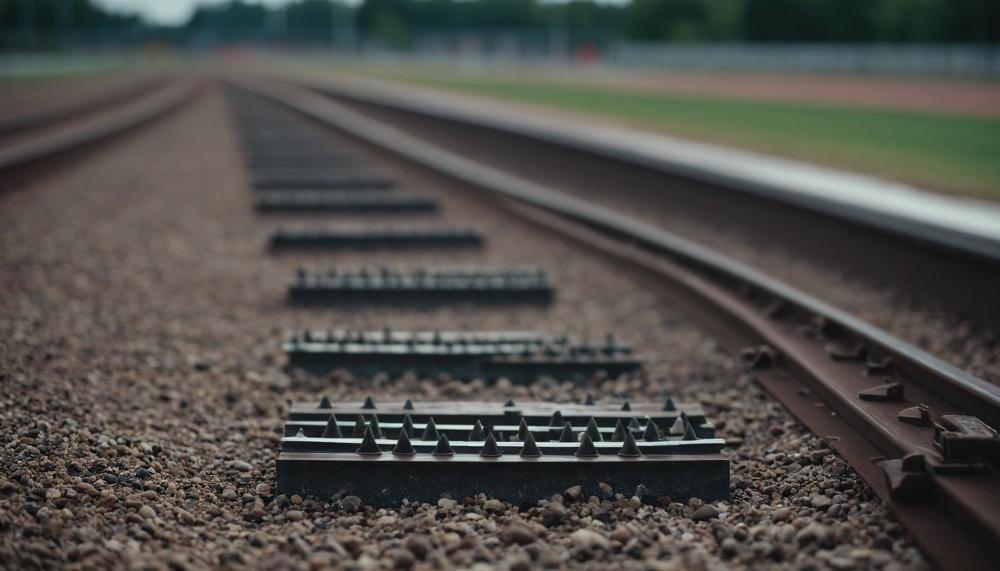Putting spikes on track shoes is a straightforward process, but it’s crucial for maximizing your performance on the track. Track shoe spikes are small metal or plastic pieces that screw into the bottom of the shoe, providing essential traction and grip. Here’s a quick guide on how to do it right:
First, select the correct type of spikes for your event and track surface. Pyramid spikes, often required for most tracks, are a popular choice. Ensure you have the right length—typically 1/4 inch is standard, but having 3/16 inch spikes on hand can be useful for meets with stricter size limits.
Next, follow these simple steps:
- Insert by Hand: Begin by inserting each spike into the holes on the sole of your track shoes by hand.
- Tighten: Use a spike wrench or pliers to firmly tighten each spike. Avoid over-tightening to prevent damage to the shoe’s sole.
- Test Run: Before competition, take a few test runs on the track to ensure the spikes are secure and provide good traction.
Key Points:

- Choose the right type and length of spikes.
- Insert spikes by hand, then tighten with a wrench or pliers.
- Avoid over-tightening.
- Test your shoes on the track before competing.
By ensuring your spikes are properly installed, you’ll gain better grip, avoid slipping, and improve your overall performance. If you hear a metallic clicking sound while running, check for loose spikes and tighten as necessary. Properly maintained spikes can make a significant difference in sprints, jumps, and other track events.
What are “Running Spikes” ?
Contents
Running spikes differ from regular track shoes in several key aspects, primarily designed to enhance speed and performance on the track. Here’s a detailed comparison:
| Feature | Running Spikes | Regular Track Shoes |
| Weight | Significantly lighter, aiming to reduce drag and maximise speed. | Heavier, providing more cushioning and support for everyday running. |
| Sole | Minimal cushioning in the heel, emphasising forefoot running. | Thicker soles with more cushioning to support various running styles. |
| Traction | Equipped with metal or plastic spikes in the forefoot to enhance grip on the track. | Smooth rubber outsoles designed for general use, offering traction on multiple surfaces but not as specialised as spikes. |
| Purpose | Designed for competition, focusing on sprints, middle-distance, and jumps. | Designed for training and general running, offering more comfort and stability. |
| Fit | Snug fit to prevent any movement inside the shoe, reducing the risk of blisters. | Comfortable fit with more room, prioritising long-term wearability. |
| Spikes | Various types of spikes (e.g., pyramid, needle) that can be adjusted based on track regulations and conditions. | No spikes; instead, they use rubber studs or textured soles for traction. |
| Regulations | Spike length and type must comply with competition rules, typically 1/4 inch pyramid spikes. | No specific regulations on the sole design, suitable for any general track usage. |
For a more detailed look at the types of spikes used and their regulations, you can refer to this Wikipedia article on track spikes. The primary benefits of using running spikes include better grip, the ability to exert full effort without slipping, and improved performance in specific track events such as sprints and jumps.
What spikes do you need?
The types of spikes used for track shoes vary based on the event and the track surface. Here’s a detailed look at the different types of spikes and how to choose the right ones for your needs:
Types of Track Shoe Spikes
| Spike Type | Description | Best Used For |
| Pyramid Spikes | These are the most common and versatile, featuring a pyramid shape that provides a good balance of traction and durability. | Suitable for all track events, especially middle-distance running and general track use. |
| Needle Spikes | These spikes are thin and sharp, offering excellent grip on softer track surfaces but can be harsh on the track, often restricted in some events. | Ideal for soft or wet track conditions and cross-country running. |
| Christmas Tree Spikes | Named for their tree-like shape, these spikes offer multi-directional grip, making them suitable for various track surfaces. | Great for sprinting and short-distance events where quick, strong traction is essential. |
Choosing the Right Spikes
When choosing spikes, consider the following factors:
- Track Regulations: Always check the regulations of the track or competition. Many tracks allow only 1/4 inch pyramid spikes to protect the surface. It’s wise to have an extra set of 3/16 inch spikes for versatility.
- Event Type: Match the spike type to your event. For example, sprinters often prefer needle or Christmas tree spikes for maximum traction, while middle-distance runners might opt for pyramid spikes for balance and durability.
- Track Surface: Evaluate the track surface. Softer, wetter tracks may benefit from needle spikes, whereas harder surfaces work well with pyramid or Christmas tree spikes.
- Spike Length: Longer spikes (1/4 inch) provide better grip but can cause more wear on the track and may be restricted. Shorter spikes (3/16 inch) are less intrusive and often a safer bet.
- Performance Needs: Assess your personal performance needs. If you require maximum grip and power for short bursts, opt for needle or Christmas tree spikes. For consistent performance across various conditions, pyramid spikes are reliable.
Practical Tips
- Inserting Spikes: Use a spike wrench or pliers to securely fasten spikes into your shoes. Test them on the track before competition to ensure they are tightly fitted.
- Maintenance: Regularly check your spikes for wear and tear, replacing them as needed to maintain optimal performance.
For more detailed information, you can refer to trusted sources like Wikipedia and track and field equipment suppliers.
A word of advice about injuries
The key to preventing injuries while putting spikes on track shoes lies in a few crucial steps:
| Precaution | Description | Importance |
| Start Gradually | Begin with form drills and strides on a soft surface for two to three weeks. | Allows muscles to adapt, reducing strain. |
| Select the Right Spike Length | Choose the appropriate spike length for your shoes, typically ranging from 3mm to 9mm. | Ensures optimal grip and prevents tripping or slipping. |
| Consider Spikeless Models | Use spikeless models for equal effectiveness and reduced injury risk. | Provides traction with added comfort, especially during training. |
| Check and Secure Spikes Properly | Ensure spikes are tightly secured. | Prevents imbalance and reduces the risk of falls or sprains. |
| Listen to Your Body | Address any discomfort or pain immediately. | Prevents worsening of early signs of injury. |
| Warm-Up and Cool Down | Incorporate thorough warm-up and cool-down routines. | Prepares body for exertion and aids in recovery. |
By following these precautions, athletes can enjoy the benefits of spikes while minimizing the risk of injury.
FREE Running Training Plans
Answer: Free running training plans are available from various reputable sources that cater to runners of all levels. Below are some of the best resources for finding comprehensive and easy-to-follow training plans:
| Resource | Description | Link |
| Hal Higdon | Offers a wide range of free training plans for different race distances, from 5Ks to marathons. Higdon’s plans are well-structured and suitable for beginners to experienced runners. | Hal Higdon |
| Runner’s World | Provides free training plans for various distances, including beginner-friendly options and advanced plans for seasoned runners. Their plans include detailed day-by-day guidance. | Runner’s World |
| MyProCoach | Features free downloadable plans designed by professional coach Phil Mosley. These plans cover everything from short races to full marathons, focusing on improving performance and endurance. | MyProCoach |
| Verywell Fit | Offers a variety of training plans for different race distances, including beginner, intermediate, and advanced levels. Plans are created by certified running coaches and fitness experts. | Verywell Fit |
| ASICS Runkeeper | Provides personalized training plans through the Runkeeper app. Users can select plans based on their goals, such as preparing for a race or improving overall fitness. | ASICS Runkeeper |
June Running Shoe GIVEAWAY
To enter the June Running Shoe GIVEAWAY and stand a chance to win a pair of Brooks Glycerin 21 running shoes, follow these simple steps:
- Provide Your Name and Email:
- Fill out the form with your name and email address.
- Eligibility:
- Ensure you enter before the deadline to be eligible.
- Selection:
- One lucky winner will be chosen from the entries.
This summer giveaway is an exciting opportunity to get your hands on a pair of high-quality running shoes. Don’t miss out.
| Step | Action | Details |
| 1 | Enter your name and email | Fill out the entry form with your personal details. |
| 2 | Ensure eligibility | Make sure to submit your entry before the deadline. |
| 3 | Wait for the selection | One winner will be chosen and notified via email. |
Conclusion
Properly installing spikes on your track shoes is a game-changer for your performance. This simple process, when done correctly, ensures maximum traction and grip, vital for any competitive track event.
Start by choosing the right spikes. Pyramid spikes are the go-to for most track events, offering a balance of traction and durability. Typically, 1/4 inch spikes are standard, but keeping 3/16 inch spikes handy can be useful for tracks with stricter regulations.
Here’s how to install them:
- Hand Insertion: Begin by manually inserting each spike into the holes on your track shoe’s sole.
- Tightening: Firmly tighten each spike using a spike wrench or pliers. Be careful not to over-tighten, as this can damage the shoe’s sole.
- Test Run: Before your competition, take a few laps on the track to ensure the spikes are secure and offer the desired traction.
By following these steps, you can prevent slipping and enhance your overall performance. Regularly check and maintain your spikes, listening for any metallic clicks that might indicate a loose spike. Well-maintained spikes can make all the difference in sprints, jumps, and other track events.
Remember, your track shoes and their spikes are tools to harness your full potential on the field.






